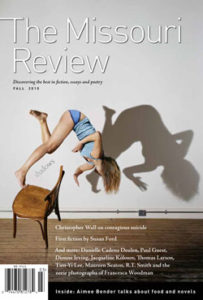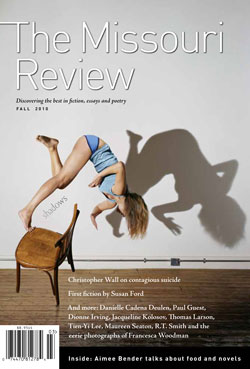ISSUES | fall 2010

33.3 (Fall 2010): Shadows
Featuring work by Danielle Cadena Deulen, Susan Ford, Paul Guest, Dionne Irving, Thomas Larson, Tien-Yi Lee, Maureen Seaton, R.T. Smith, Christopher Wall, Michael White… as well as a look at the art of Francesca Woodman and an interview with Aimee Bender.
CONTENT FROM THIS ISSUE

Art
Sep 01 2010
Clues to a Lost Woman: The Photography of Francesca Woodman
Examination of the art of photographer Francesca Woodman, who committed suicide in 1981.

Nonfiction
Sep 01 2010
"Look Down, Don't Look Down"
One afternoon during the fall of my senior year, I found myself camped out on some industrial tile near the Hamden High School pool with a spiral-bound reader, halfway through Jean-Paul Sartre’s “Concrete Relations with Others” and already drowning in his words. Pursued-pursuing. Transcendence-transcended. Being-in-Itself. I was highlighting a chapter of Sartre’s philosophical treatise while waiting for my girlfriend’s swim meet to begin, but every time I made it through a few sentences, I found it difficult to breathe.

Foreword
Sep 01 2010
The Shadow
While Jung gave a name to an amoral and potentially “dark” side of the mind, the idea is of course as old as dragons, devils and demons. The pulp fiction, comic-book series and radio show The Shadow became an often-imitated model for popular dramatizations of “what evil lurks in the hearts of men” and the trickster figure who fights against it. Several of the contributors to this issue explore different corners of the dark or destructive forces in human nature.

Interviews
Sep 01 2010
A Conversation with Aimee Bender
Brian Beglin conducted this interview over the phone and through e-mail with Aimee Bender in May and June 2010.

Poetry
Sep 01 2010
Poetry Feature: Paul Guest
Featuring the poems: LOVE SONG WITH RUIN, EROS POETICA, SINCERELY, INVOCATION, FORGET

Poetry
Sep 01 2010
Poetry Feature: Maureen Seaton
Featuring the poems: When I Was the Virgin of Westchester, When I Was The Donna Reed Show, When I Was Infertile, Metastasis, Helplessly Hetero

Fiction
Sep 01 2010
First Meeting
Hey there. My name is Connie Aderholt, and I’m an alcoholic. From way back. About the time I changed from Conrad to Connie after a baseball player, that was when I got hooked on hooch. All kinds, canned brew to cinnamon schnapps, Mateus to single barrel scotch. Fifteen, just barely, brought to it in a shed behind the Starfest Café by Ellie Winston, who was stripped to heels, hose and a choker ribbon with a quart of Beam raised high in each hand.

Reviews
Sep 01 2010
Into History: A New Terrain of Women's Poetry
Reviews of:
Sarah Kennedy, Home Remedies, Louisiana State University Press, 2009, 70 pp., $17.95 (paper).
Frannie Lindsay, Mayweed, The Word Works, 2009, 76 pp., $15 (paper).
Rebecca Foust, All That Gorgeous Pitiless Song, Wave Books, 2010, 80 pp., $15.95 (paper).
Sara London, Tyranny of Milk, Four Way Books, 2010, 100 pp., $15.95 (paper).

Fiction
Sep 01 2010
How I Came to Love You Like a Brother
At the mention of the other woman, our mother spat. Once, I suppose, she would have wanted to know more, like what did he do, or how old were the children, or what were their names, or did they play musical instruments, and she might have told him that Lucia could recite thirty Chinese poems by the time she was three, or that she was a real talent on the flute, or that Lucia’s great-grandfather, originally a poor rice farmer, escaped from Qing militarists to become Sun Yat-Sen’s right-hand man in 1912.

Poetry
Sep 01 2010
Poetry Feature: Danielle Cadena Deulen
Featuring the poems: Corrida de Toros, Fig, After the Twentieth Century, Lacan at the Carousel, I Want You Dangerously, Revolution

Nonfiction
Sep 01 2010
Bard of the Bottle
Tom was a terrible influence, of course. That friendship was scorched earth. He died at fifty-four, though he looked a couple of decades older. I just turned fifty-four yesterday. But that friendship made me everything I am. Without it, I wouldn’t even be a poet, I think…

Fiction
Sep 01 2010
Florida Lives
Roaches don’t die easy deaths; they can survive nearly anything. Everywhere else I’ve ever lived-New York, San Francisco, a rented cottage in Alaska-they call them roaches. But in Florida, a blend of kudzu and heat, a mixture of North and South, a dangling participle on the United States, they are palmetto bugs.

Fiction
Sep 01 2010
Of Questionable Provenance
The autumns I come to New York for the antiquarian book fair, it is my habit before breakfasting to walk from my hotel up Fifth Avenue to Seventy-second Street and then back through the park, where the people who acknowledge my “Good morning” are invariably men or women of a certain age. My own age, much to my surprise, now groups me with them, and my preoccupations with self, such as they were, have ebbed to the point where I am more interested in other people’s lives than in my own.

Nonfiction
Sep 01 2010
The Saddest Music Ever Written: Samuel Barber's Adagio for Strings
Barber’s Adagio is the Pietá of music. It captures the sorrow and the pity of tragic death: listening to it, we are Mother Mary, come alive-holding the lifeless Christ on our laps, one arm bracing the slumped head, the other offering him to the ages. The Adagio is a sound shrine to music’s power to evoke emotion. Its elegiac descent is among the most moving expressions of grief in any art. The snail-like tempo, the constrained melodic line, its rise and fall, the periodic rests, the harmonic repetition, the harmonic color, the uphill slog, the climactic moment of its peaked eruption-all are crafted together into one magnificent effect: listeners, weeping in anguish, bear the glory and gravity of their grief. No sadder music has ever been written.
